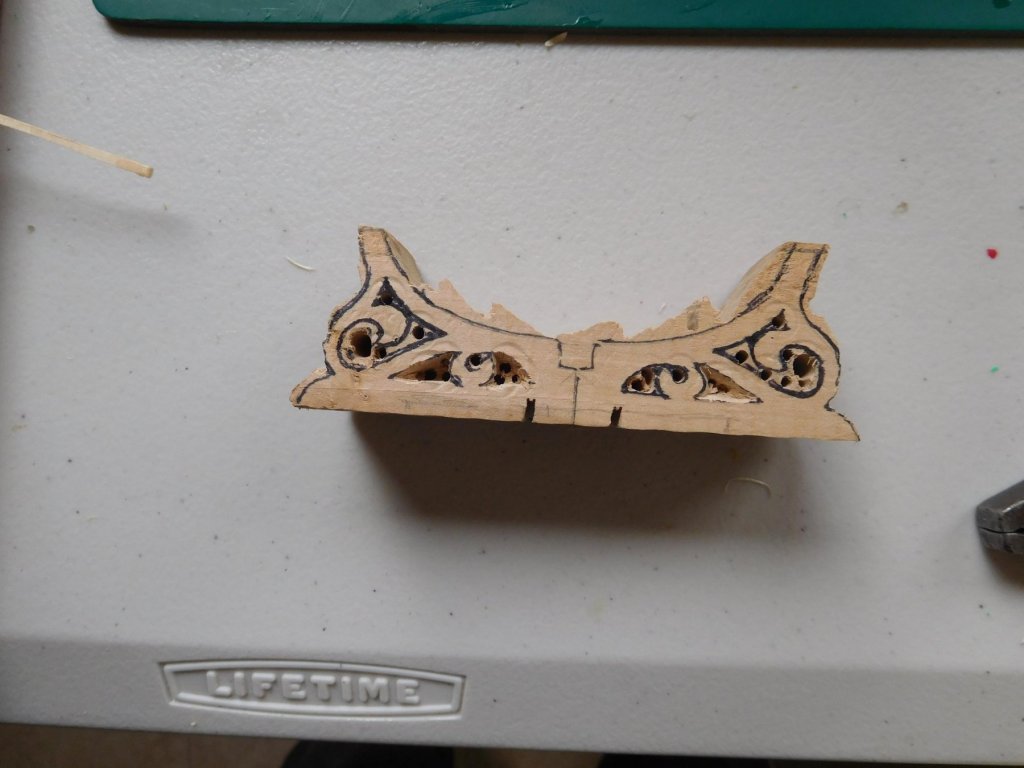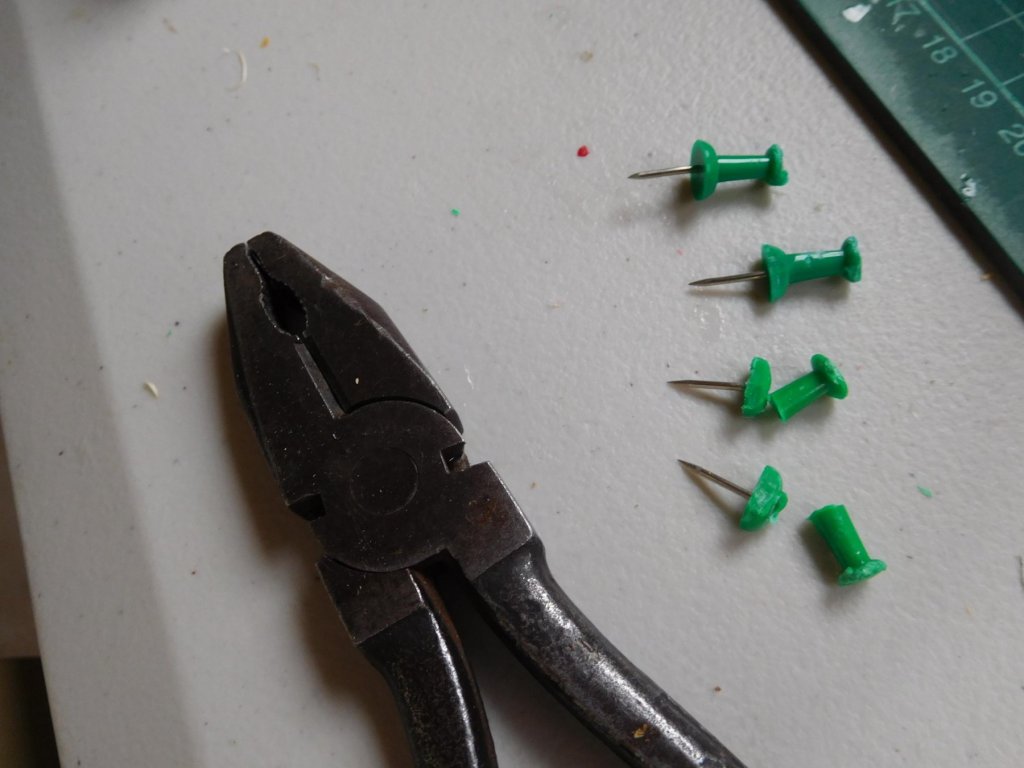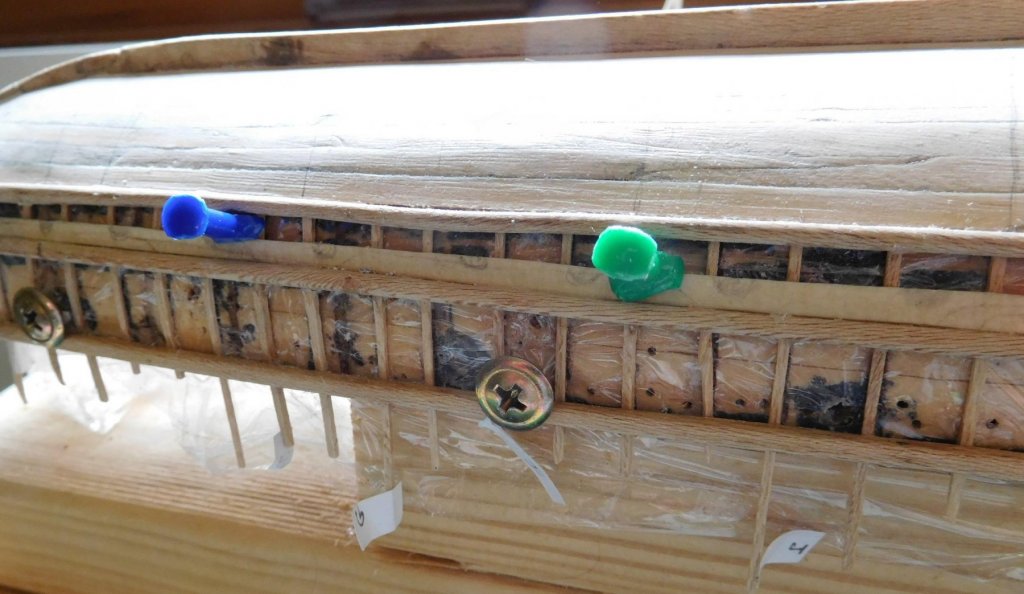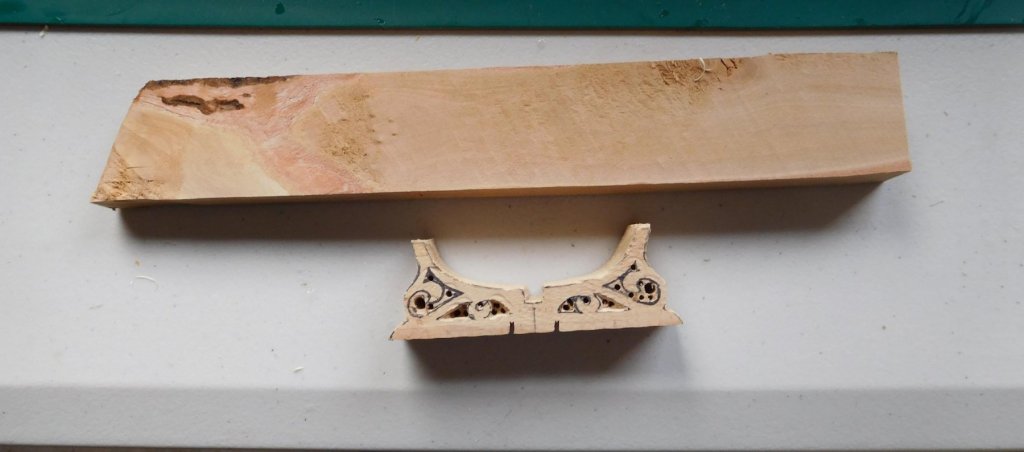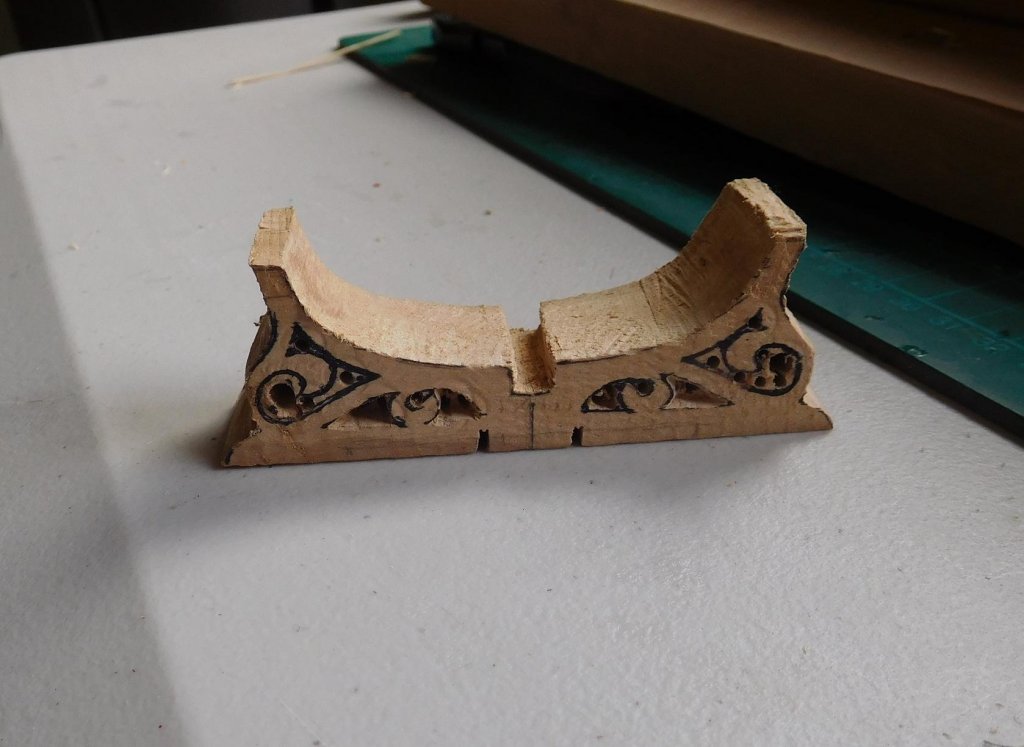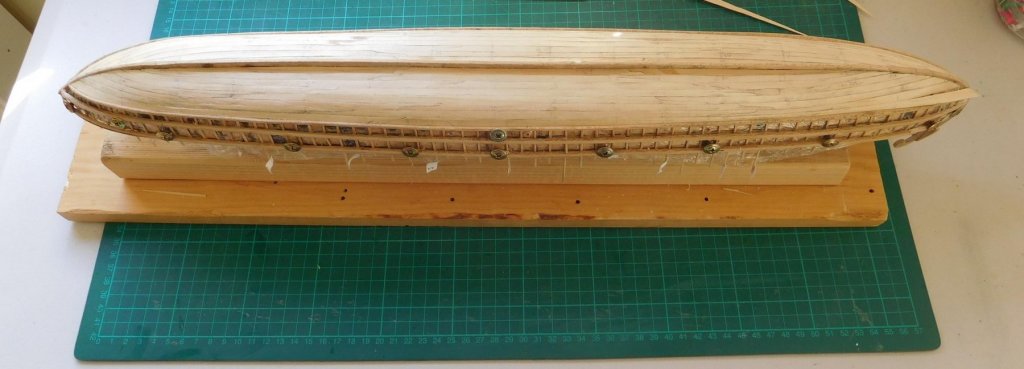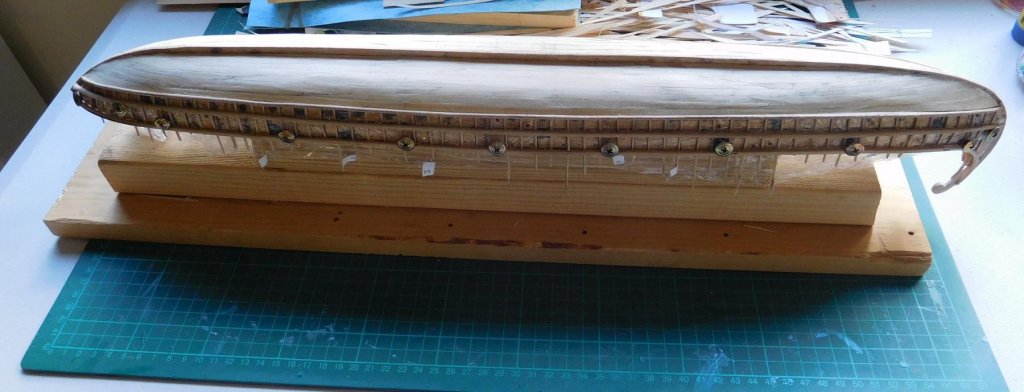-
Posts
7,987 -
Joined
-
Last visited
Content Type
Profiles
Forums
Gallery
Events
Everything posted by Louie da fly
-
At least I can answer the one about the preventer stay - it was a back-up for the stay itself in case it broke. Instead of an almighty disaster you'd have a nuisance - you'd still have to replace the stay itself as soon as possible, but in the meantime the preventer stay would hold the mast in place. Steven
-
I doubt there were many "well-built" crewmen on a carrack - at least among the topmen. The cook, maybe . . . By the way, Dick, I really ought to take the opportunity to say how good that ship looks, and how well she resembles the contemporary pictures. That last profile picture of her really shows up what a magnificent job you've done. Steven
-
Thanks, Carl, but I've gone too far now to change tack (sorry!). Anyway, the faults aren't all that obvious to the naked eye and should respond very nicely to a bit of judicious filling (By the way, anybody recommend a good filler? Otherwise I'll use thinned white glue and sawdust from the build - I've got oodles of it!). And once filled and painted, they should vanish. The thing is, with the wonderful examples on this forum I'd set my sights pretty high for what was really my first serious set of planking. That I didn't reach that exalted level first time isn't really anything to be upset about. Though I'd have liked the planks to run more smoothly together like the ones the experienced guys do, I'm actually rather proud of the results I've got. Steven
-
I've been working on the stand for the ship in between times. Here are some progress pics. Roughly sawn to shape and holes drilled for the openwork, which I've made a start on. The timber is pearwood, from the neighbour's tree. Once it's shaped I'll cut two layers about 4 or 5mm thick to make the ends of the stand. Smoothed off the outside shape somewhat, and roughed out a bit of pearwood to make the joining strip from. It will fit in a horizontal slot at the bottom to join the two parts of the stand. When I'm planking sometimes the heads of the pushpins are too big to fit in the space available, so I've been trimming them down with a Stanley knife. Unfortunately they aren't all that strong and when you try to adjust the position of one, or take it out with a pair of pliers . . . It's great fun trying to lever half a push pin out of the plug with a knife blade, without destroying the planking adjoining it. Steven
-
Thanks Banyan and Druxey. It means a lot coming from people like you. If I can emulate the quality of your work I'll consider myself a true ship modeller. Steven
-
As the hero of The Castle said "Yeah, but you've done something to it . . ." That's worthy of going into the Pool Room along with the jousting sticks . . . Steven
-
Greg, you never fail to amaze me with the quality of your work. Lesser mortals like me can only gasp in awe. Steven
-
Selamat datang, Jonk. I've always admired traditional Indonesian ships and boats. They are very elegant. Steven
-
Thanks, Russ. And thanks everybody for the likes. I just realised today why I've been having so much trouble, having to cut exaggeratedly curved planks for the bow and stern which get wider and wider as they approach the ends. It all comes down to making the garboard strake far too short due to inexperience. I misinterpreted a tutorial and now have to live with the result. It's far too late to fix it now - if I tried removing the planks I'd destroy the frames because they're so frail. So I'm putting it down to experience and I'll do better on the next model I make. I've found my planking technique has improved as I've gone along, however. I've been working on the starboard side planking. Here's some progress pics. On the last photo above you can see the effect of getting the garboard strake wrong - the gap between the top plank and the wale should be pretty much the same all the way along the hull, but it's become far too wide at bow and stern. I won't make that mistake again. I've got the underwater hull completely planked now, and I'm about to start on the sides. Looking forward to finishing and taking her off the plug at last! The planks are a little wonky - caused by really thin planks over frames not perfectly in line because I'd cut grooves in the plug for them. Another mistake that won't be made a second time. If ship modelling is all about learning from your mistakes, I've certainly learnt a lot! Still, nil desperandum - I'm having a lot of fun with it and the faults (that are so obvious to me at the moment) won't detract from the final model. And with experience I'm becoming a better modeller. Steven
-
I've put this in my favourites as an example of difficult planking done well. Well? - - - Magnificently! Steven
- 525 replies
-
- anchor hoy
- hoy
-
(and 1 more)
Tagged with:
-
How big are those lubber holes, Dick? Are they big enough for someone to squeeze through? They look rather small - but doubtless you've already worked that all out. Steven
-
Hi Götz, Woodrat got here before me, but I was going to recommend you look at his build anyway. But I didn't know he was going to work on the top next! I haven't seen your top against your ship to compare sizes, but tops were very big at this time. I think ratlines would be appropriate for a Hanseatic ship - most northern vessels from this period seem to have had them. Steven
-
Yes, that's a very nice looking set of lines, Russ. A very attractive shape. (I wish I was as good at planking as you are). Steven
- 420 replies
-
- captain roy
- lugger
-
(and 2 more)
Tagged with:
-
Goetzi, I wouldn't want to impose standards or expectations on you. Ship modelling is fun, not some kind of competition. I added the links and pictures in the hope that you might find them useful, and because I love the ships of this period. I don't think enough people make models from this time (except of course the Santa Maria!) and I love to see someone embark on building one. And I've already learnt quite a bit from yours. Your work so far looks very good - crisp and precise. I look forward to following your build.
-
I agree, Christian, and I think the forecastle could perhaps be re-thought. The one on the Lisa seems a bit too "boxy" for the period. As far as the stern goes, I don't know if flat sterns were in use as early as 1500, but the Navicula Penitentie (printed in Augsburg) shows them by 1511. Both this ship and the Mary Rose of 1510 are basically carracks but with a caravel's stern. And the name Kraweel appears to come from caravel. Steven
-
Hi Götz, My German isn't good enough to read this site without help, but Google translate is pretty good - you can usually work out what it's supposed to say! Thanks for this information. I'd heard of the Hanse ports, but not of a kraweel. Yes, the Lomellina is contemporary and the Mary Rose is only a few decades different, but neither of them are Hanse ships, and it's pretty certain that there were major differences in building techniques and design between Hanse and other shipbuilders. I found these on the Net. They appear to be from about the right time frame The second is from Hamburg and the first has architecture reminiscent of Du"rer's pictures of German buildings (though they could equally be Dutch or Scandinavian). The ships in both have round sterns, unlike yours, but certainly by 1510 when the Mary Rose was laid down, flat sterns were in use. There vis also the flat-sterned ship on the front cover of Johann Geiler von Kayserberg’s Navicula Penitentie of 1511 here, and also you could do an image search on "ship of fools" for quite a few German examples of ships from the turn of the 16th century - some quite similar to your own, others with at least details that might be of use to you. 1494 1494? 1494 The picture by Ambrosius Holbein on the cover page of Thomas More's Utopia printed in 1516 has an interesting ship, though I don't believe the bows of ships of the time sloped backwards the way it's shown in the picture. Good luck with the build. If I can be of any help, please let me know. But we need photos of your build! Steven
-
The Lomellina, a Genoese carrack which sank in 1516 had a capstan just aft of the foremast - see http://archeonavale.org/lomellina/an/l_102a.html its keel is 34.18 metres (112 feet) long with a 2.25 metre stempost (the sternpost is missing) - see http://archeonavale.org/lomellina/an/l_9a.html - compared with Mary Rose's 32 metres (I don't know if this was length of keel or overall length). The home page of the excavation is at http://archeonavale.org/lomellina/index.html The Red Bay wreck of 1565, though later (and a galleon, not a carrack), also had a capstan, between the main and mizzen masts (see http://www.patrimoniocultural.gov.pt/media/uploads/trabalhosdearqueologia/18/22.pdf ), though it's debatable whether this was for the anchor. The Complaynte of Scotland of 1548 refers to the anchor being raised by a capstan. I hope this is of help. Steven
-
Impatience, mostly. After all the preamble and preparation, I really wanted to see what she'd look like. If I'd done it in tandem it would have taken twice as long to find out. As she was done on a plug there was no danger of an imbalance of forces from the planks on one side causing her to warp before the others were put on. Of course, I could have just taken the photos of one side and pretended I'd done both . . . Steven
-
Very interesting Goetzi! This is a period and type of ship I'm very interested in. It is a little later than Woodrat's carrack or Nave Tonda, which you can also see in the scratch built forum. Though Venetian ships had many differences from those of the north, there were also great similarities. The main difference from carracks I can see from a brief glance is that yours is flat sterned, while those of carracks were round. The flat stern was just coming in about this time, and went on to be the dominant form for two centuries. I'd recommend you have a look through Woodrat's excellent build log - he's done a huge amount of research into ships of this period and you may pick up some valuable information. Some time ago I put up some links about vessels of this period at and and which I hope you you might find useful. Not only the shape of the ship itself, but very valuable images of artefacts etc. Looking forward to following your build! Steven
About us
Modelshipworld - Advancing Ship Modeling through Research
SSL Secured
Your security is important for us so this Website is SSL-Secured
NRG Mailing Address
Nautical Research Guild
237 South Lincoln Street
Westmont IL, 60559-1917
Model Ship World ® and the MSW logo are Registered Trademarks, and belong to the Nautical Research Guild (United States Patent and Trademark Office: No. 6,929,264 & No. 6,929,274, registered Dec. 20, 2022)
Helpful Links
About the NRG
If you enjoy building ship models that are historically accurate as well as beautiful, then The Nautical Research Guild (NRG) is just right for you.
The Guild is a non-profit educational organization whose mission is to “Advance Ship Modeling Through Research”. We provide support to our members in their efforts to raise the quality of their model ships.
The Nautical Research Guild has published our world-renowned quarterly magazine, The Nautical Research Journal, since 1955. The pages of the Journal are full of articles by accomplished ship modelers who show you how they create those exquisite details on their models, and by maritime historians who show you the correct details to build. The Journal is available in both print and digital editions. Go to the NRG web site (www.thenrg.org) to download a complimentary digital copy of the Journal. The NRG also publishes plan sets, books and compilations of back issues of the Journal and the former Ships in Scale and Model Ship Builder magazines.




